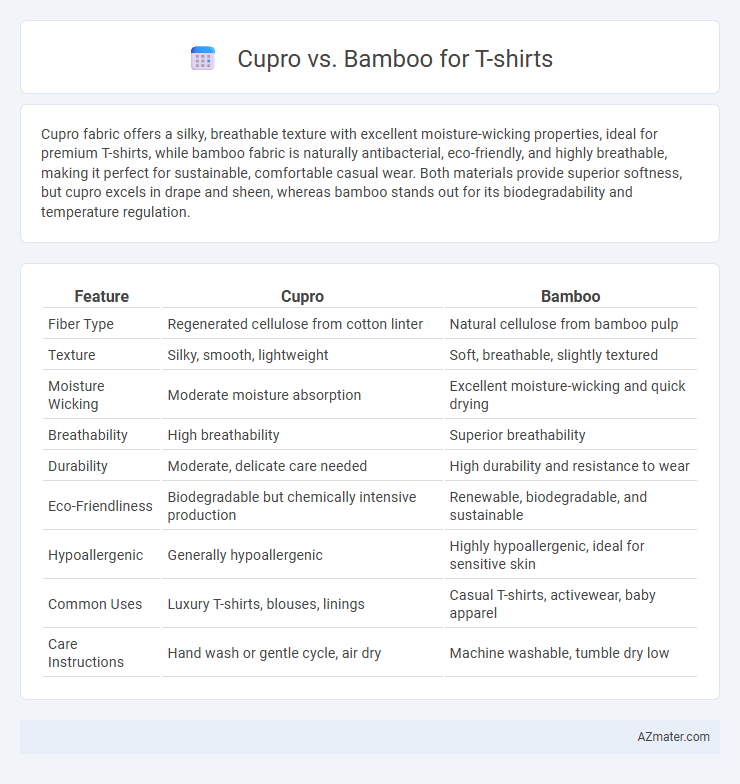Cupro fabric offers a silky, breathable texture with excellent moisture-wicking properties, ideal for premium T-shirts, while bamboo fabric is naturally antibacterial, eco-friendly, and highly breathable, making it perfect for sustainable, comfortable casual wear. Both materials provide superior softness, but cupro excels in drape and sheen, whereas bamboo stands out for its biodegradability and temperature regulation.
Table of Comparison
| Feature | Cupro | Bamboo |
|---|---|---|
| Fiber Type | Regenerated cellulose from cotton linter | Natural cellulose from bamboo pulp |
| Texture | Silky, smooth, lightweight | Soft, breathable, slightly textured |
| Moisture Wicking | Moderate moisture absorption | Excellent moisture-wicking and quick drying |
| Breathability | High breathability | Superior breathability |
| Durability | Moderate, delicate care needed | High durability and resistance to wear |
| Eco-Friendliness | Biodegradable but chemically intensive production | Renewable, biodegradable, and sustainable |
| Hypoallergenic | Generally hypoallergenic | Highly hypoallergenic, ideal for sensitive skin |
| Common Uses | Luxury T-shirts, blouses, linings | Casual T-shirts, activewear, baby apparel |
| Care Instructions | Hand wash or gentle cycle, air dry | Machine washable, tumble dry low |
Introduction to Cupro and Bamboo Fabrics
Cupro fabric, derived from regenerated cellulose fibers sourced from cotton linter, offers a silky texture, high breathability, and excellent moisture absorption, making it ideal for premium T-shirts. Bamboo fabric, created from bamboo pulp through a mechanical or chemical process, is renowned for its natural antibacterial properties, softness, and eco-friendliness, providing sustainable comfort for everyday wear. Both materials prioritize comfort and sustainability but differ in fiber origin, processing methods, and fabric characteristics.
What is Cupro?
Cupro, a regenerated cellulose fiber derived from cotton linter, offers a silky texture and excellent breathability, making it an ideal fabric for T-shirts seeking comfort and moisture-wicking properties. Unlike bamboo, which is a natural cellulose fiber obtained from bamboo plants, Cupro undergoes a chemical process that enhances its softness and drape, providing a luxurious feel similar to silk. Cupro T-shirts are biodegradable and hypoallergenic, appealing to eco-conscious consumers looking for sustainable and skin-friendly apparel options.
What is Bamboo Fabric?
Bamboo fabric is derived from the pulp of bamboo grass, processed into a soft, breathable textile known for its natural moisture-wicking and antibacterial properties. It offers eco-friendly benefits due to bamboo's rapid growth and minimal need for pesticides, making it a sustainable choice for T-shirts. Compared to Cupro, bamboo fabric tends to be lighter, cooler, and ideal for sensitive skin, enhancing comfort in casual wear.
Sustainability: Cupro vs Bamboo
Cupro fabric is derived from cellulose fibers extracted from cotton linter, offering a closed-loop production process that recycles chemicals and water, making it highly sustainable. Bamboo fabric is praised for its rapid growth and minimal need for pesticides, but its environmental impact varies significantly depending on the manufacturing process, ranging from eco-friendly mechanical extraction to chemical-intensive viscose methods. Evaluating Cupro vs Bamboo sustainability involves considering resource regeneration, chemical use, and factory emissions, with Cupro leaning towards eco-conscious production and Bamboo's sustainability dependent on processing techniques.
Comfort and Feel: Wearability Comparison
Cupro fabric offers a silky, smooth texture that feels lightweight and breathable against the skin, making it ideal for sensitive skin and hot climates. Bamboo fabric boasts a soft, moisture-wicking quality with natural antibacterial properties, providing excellent comfort and odor resistance during extended wear. Both materials excel in wearability by delivering breathable, soft textures, but Cupro leans towards a more luxurious feel while bamboo emphasizes natural softness and moisture management.
Moisture-Wicking and Breathability
Cupro fabric, derived from regenerated cellulose fibers, offers excellent moisture-wicking properties by effectively drawing sweat away from the skin, keeping wearers dry and comfortable. Bamboo fabric, known for its natural breathability and antimicrobial qualities, promotes airflow and reduces odor, enhancing comfort during extended wear. Both materials outperform traditional cotton in maintaining dryness and ventilation, with Cupro excelling in moisture management and Bamboo providing superior breathability.
Durability and Longevity
Cupro fabric offers excellent durability due to its strong regenerated cellulose fibers, making it resistant to pilling and maintaining shape after multiple washes. Bamboo fabric, while naturally antibacterial and soft, tends to weaken faster when exposed to frequent laundering and sunlight, which can reduce the lifespan of bamboo T-shirts. For long-lasting wear, Cupro-based T-shirts typically outperform bamboo options in retaining strength and appearance over time.
Care and Maintenance
Cupro T-shirts require gentle hand washing or delicate machine cycles with mild detergent to preserve their silky texture and prevent shrinkage, avoiding bleach and high heat drying. Bamboo T-shirts are known for their durability and moisture-wicking properties, allowing machine wash on cold settings with similar mild detergents and low heat tumble drying to maintain softness and prevent fabric damage. Both fabrics benefit from air drying and ironing on low heat to extend the lifespan and maintain shape.
Price and Availability
Cupro T-shirts generally have a higher price point due to the complex manufacturing process and limited production facilities, making them less widely available compared to bamboo options. Bamboo T-shirts are more affordable and benefit from mass production, resulting in greater availability across various retail channels. Both materials offer sustainable alternatives, but bamboo remains more accessible and budget-friendly for consumers.
Which is Better for T-Shirts: Cupro or Bamboo?
Cupro fabric offers a silky texture, excellent breathability, and moisture-wicking properties, making it ideal for comfortable, luxurious T-shirts, while bamboo fabric excels in antimicrobial qualities, sustainability, and softness, providing natural odor resistance and hypoallergenic benefits. Bamboo T-shirts tend to be more eco-friendly due to bamboo's rapid growth and minimal pesticide use, whereas Cupro, a regenerated cellulose fiber from cotton linter, offers superior drape and sheen. Selecting between Cupro and bamboo for T-shirts depends on priorities like softness, environmental impact, and functional benefits such as odor control and breathability.

Infographic: Cupro vs Bamboo for T-shirt
 azmater.com
azmater.com